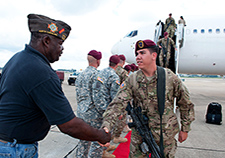Office of Research & Development |
 |

VA Research Currents archive
December 16, 2015

Roland Rochester, left, of the Veterans of Foreign Wars greets Army paratroopers as they return from Afghanistan to Fort Bragg in 2012. (Photo by Sgt. Michael J. MacLeod/USA)
About 48 percent of Army Veterans who served on active duty in Iraq or Afghanistan enrolled in and used VA care within one year of separation from the military, reported VA researchers and colleagues in the October 2015 issue of Military Medicine. The studyincluded more than 151,000 active-duty members who had deployed and then separated from the Army between 2008 and 2012.
A companion study published a year ago in Military Medicine found roughly similar rates for Iraq and Afghanistan Veterans who had served in Army National Guard and Reserve units. Of the more than 125,000 National Guard and more than 48,000 Reserve members included in that study, about 57 percent and 46 percent, respectively, had enrolled in VA care within 12 months of being demobilized.
Some VA facilities attracted only 30 to 40 percent of the Army active-duty Veterans in their catchment area. Facilities on the high end enrolled more than 70 percent.
Together, say the authors of the new study, "this work suggests that about half of OEF/OIF Army service members enroll in VHA and utilize services in the first year following eligibility."
The new study was led by Dr. Megan Vanneman with the Center for Innovation to Implementation (Ci2i) at the VA Palo Alto Health Care System, and the Center for Health Policy/Primary Care and Outcomes Research at the Stanford University School of Medicine.
In both studies, the linkage to VA after separation or demobilization varied greatly by facility. While the researchers don't disclose specific facility names in the papers, they show that on the low end, some VA facilities attracted only 30 to 40 percent of the Army active-duty Veterans in their catchment area. VA facilities on the high end enrolled more than 70 percent of eligible Army Veterans in their area.
Vanneman and colleagues write that the gaps could stem from such things as "differences in facility-level outreach, perceived quality at the facility level, facility-specific waiting lists and scheduling practices, and/or local availability of [non-VA health care.]"
In the active-duty study, the researchers identified three main factors that seemed to predict which Veterans would enroll in VA. One was serious injury during deployment. Another was separation because of disability. A third was past experience with VA care.
Another factor that emerged in the active-duty study was rank. Those above junior enlisted rank were less likely to enroll in VA. The researchers say these Veterans could be more likely to have access to non-VA care—say, through employer-sponsored health insurance.
The researchers are continuing to study Iraq and Afghanistan Veterans' enrollment in VA. One upcoming related article will address the relationship between post-deployment mental health screen scores and linkage to VA.
Vanneman worked on the active-duty study with collaborators from Ci2i, Brandeis University, and the Defense Health Agency. Support for both studies came from the National Institute on Drug Abuse, VA Health Services Research and Development, and the VA Office of Academic Affiliations.
In a separate project, Vanneman and colleagues at Ci2i and VA's Health Economics Resource Center are looking at the impact of the Veterans Choice Program on the use of VA health care by Veterans of operations Enduring Freedom, Iraqi Freedom, and New Dawn. The program allows VA-enrolled Veterans to receive care in their communities, instead of at VA facilities, provided they meet certain criteria.
The researchers say their findings could help both VA and the Department of Defense better target efforts to link Veterans to care.